

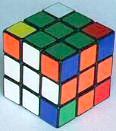
Fig. 7a Fig. 7b Fig. 7c
STEP FOUR: FIVE CORNER PIECES
Once the edge pieces have been correctly placed you will look for corner pieces which can be moved into position/orientation by a Corner Piece Series. In the discussion of that series we learned that one or more corner pieces will, almost inevitably, be situated so that this series will move that corner piece along a cube edge and into position/orientation. Others will be in a position, such that the series will move them across a face diagonal and into the correct position and orientation.
Figure 7a shows the first kind of corner piece in the front/top/right corner of the cube. The proper series will move the green/red/white corner piece along the green/red edge of the cube and into its correct position and orientation at the back/top/right corner of the cube. (That is, in the green/red/white corner.) In orienting these cubes we will always use the same convention. We will always show the front, right and top of the cube. In this case that means blue is the front, red is the right side and green is the top.



Fig. 7a
Fig. 7b
Fig. 7c
If the entire cube is turned 90o counterclockwise we obtain the cube in Fig. 7b. Now orange is front and blue is right. A standard Corner Piece Series which begins with a turn of the top face to the right will move our target corner piece to the back/top/left corner. It will be correctly placed in the green/red/white corner of the cube.
Turning the cube another 90o counterclockwise gives the cube in Fig. 7c. The Corner Piece Series is the same (it begins with a turn of the top face to the right) but the target corner piece now moves along the left/top edge rather than the back/top edge. You can use either orientation of the cube and still move the green/red/white corner piece into place. The difference is that the blue/green/orange corner piece is involved in moving about the first triangle and the blue/red/yellow corner piece has replaced it in the second case.
The red/yellow/blue corner piece is at front/top/right in Fig. 7d. This corner piece belongs somewhere on the top face because of its blue color. But the red and yellow colors do not match the other two sides (front and right) which we can see. Yellow is opposite green and red is opposite orange so this red/yellow/blue corner piece belongs in the back/top/left corner of the cube.

Fig. 7d
A Corner Piece Series which begins with a turn of the top face to the left will cause the red/yellow/blue piece to move across the diagonal of the top face and into place in the back/top/left corner. In this case there is only one way this can happen.
If possible, one would like to place two corner pieces at the same time. You may find, by chance, that a piece goes along an edge while another goes across the face diagonal at the same time. Or perhaps two may move along adjacent cube edges. But most of the time you will have to arrange for these things to happen.
While other solutions will use a relatively large number of series in solving a scrambled cube this method is able to solve a cube while using only two series because of the use of preliminary face turns which change the corner pieces involved in a Corner Piece Series.
Turning the orange face in Fig. 7c by 180o gives Fig. 7e. We apply the same Corner Piece Series as before (start with a turn of the top face to the right) but the blue/red/green piece has become a part of the triangle. This is the piece which belongs at back/top/left and it is not only moved to the correct position it is also properly oriented. Two corner pieces have moved into place at the same time. Following this series the orange face is again turned 180o returning it to its original position.

Fig. 7e
The problem with this approach is that you will have to search for the new piece without any clue as to where it will be found. Rather than trying to find the piece which will replace your target piece, it is better to work with the piece which the target piece is going to replace. This is true because a glance at the latter piece will immediately tell you where it must go.
The target piece in Fig. 7c will replace the orange/yellow/blue corner piece at front/top/left. The Corner Piece Series (first turn is to the right) will move this piece across the diagonal with its blue face coming to the top. But where does the orange/yellow/blue corner piece belong? Since none of its colors match any of the faces it touches it must belong in the opposite corner of the cube. And more specifically its blue color must be in the blue face of the cube.
The front of the cube is white so the back is blue. Turn the orange face (in Fig. 7c) 90o counterclockwise and you get Fig. 7f. Apply the Corner Piece Series and the blue color of the orange/blue/yellow corner piece moves next to the blue color of the blue/orange edge piece. Turn the orange face 90o clockwise and two corner pieces have been moved into place.
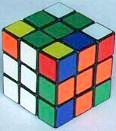


Fig. 7f
Fig. 8a
Fig. 8b
Fig. 8a shows another example. The orange/blue/green corner piece at back/top/right will move along the top/right edge of the cube and "roll over" into proper position/orientation in the front/top/right corner of the cube. It replaces the yellow/blue/red corner piece. What needs to be done to cause the latter piece to move into position/orientation at the same time?
According to its colors the yellow/blue/red piece belongs in the corner diagonally across the blue face of the cube. Rotate the yellow (left) face of the cube 180o giving Fig. 8b. Apply the Corner Piece Series (first turn of the top face is to the left) and the yellow/blue/red piece moves into place with its red color next to the red edge piece color on the left side of the top face. A second 180o turn of the left face and two corner pieces have moved into place during the same sequence of moves.
Fig. 9a shows a potential problem. A Corner Piece Series (first turn of the top face is to the left) moves the red/yellow/blue piece across the blue (top) face of the cube to its correct position and orientation. But it would also move the yellow/blue/orange out of place. To avoid this, turn the orange face 90o clockwise (giving the cube in Fig. 9b) and apply a Corner Piece Series which begins with a turn of the top face to the right. Reverse the preliminary turn of the orange face. The red/yellow/blue piece winds up in the correct place but the yellow/blue/orange piece is not disturbed.

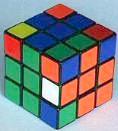
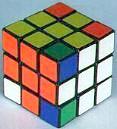
Fig. 9a
Fig. 9b
Fig. 10a
We could move three corner pieces on the top face of the cube in Fig. 10a about the triangle: front/top/right; back/top/left; back/top/right. The yellow/orange/white piece at back/top/right moves along the top/right edge and rolls over into place at front/top/right. The blue color of orange/green/blue comes to the top in the back/top/left corner. This piece belongs in the front/bottom/left corner. The blue color of the orange/green/blue piece obviously must go in the blue (left) face of the cube. It must replace the red color of the piece which is now there.
Turn the bottom face 90o counterclockwise and then turn the left face 90o clockwise. This gives the cube in Fig. 10b. A Corner Piece Series which begins with a turn of the top face to the left causes the blue color of the orange/green/blue piece to replace the red color we see in the back/top/left corner of the cube. Then reverse the two preliminary turns (left face 90o counterclockwise, bottom face 90o clockwise). Again we have placed two corner pieces during the same sequence.


Fig. 10b
Fig. 11
The blue/yellow/red corner piece at front/top/left in Fig. 11 could move along the front/top edge and roll over into place at front/top/right. But we do not have a triangle of three out-of-place corner pieces on the top face. No problem. Rotate the white face 90o clockwise and the out-of-place piece at back/bottom/right comes to the top face making a temporary triangle. Apply the Corner Piece Series and then turn the white face 90o counterclockwise.
The yellow/red/blue piece at front/top/left in Fig. 12a will move along the front/top edge and into place at front/top/right. The green/red/blue piece has the most difficult situation you will find in trying to place two corner pieces at the same time. This is indicated by the checkerboard appearance it makes with the red/blue edge piece next to it. This corner piece belongs at back/top/right and its green face must be in the green face of the cube.
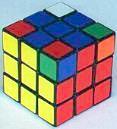

Fig. 12a
Fig. 12b
It will replace the blue/green/orange corner piece which now has its blue face in the green face of the cube. This means we must find (create) a Corner Piece Series in which the green face of the green/red/blue piece replaces the blue face of the blue/orange/green piece. Turn the green face 90o counterclockwise; turn the white (bottom) face 90o clockwise; and turn the green face 90o counterclockwise. We have the cube in Fig. 12b. As required, the blue face we are looking for is on the top face at back/top/left.
Apply a Corner Piece Series moving corner pieces about the triangle: front/top/left; front/top/right; back/top/left. Now reverse the preliminary turns (green face 90o clockwise; white face 90o counterclockwise; green face 90o clockwise). Again, two corner pieces have been moved into place at the same time.
The cube in Fig. 13 shows an unusual arrangement. The pieces making a checkerboard pattern on opposite sides of the red/yellow edge piece need to be exchanged as do the pieces across the diagonal on the white face. We could put one of the first pair in place using the preliminary three turn sequence described in the previous paragraph. Or we could put one of the latter pair in place using a two turn sequence. We will do the latter simply because it is shorter.

Fig. 13
Move the green/red/white corner piece so that it is across the cube diagonal (not a face diagonal) from its proper position (turn the orange face 90o counterclockwise). Next turn the blue (bottom) face 90o counterclockwise. Note that this turn is at right angles to the first turn. Now the green/red/white corner piece is diagonally across the red face from its proper position and can be moved into position and orientation with the proper Corner Piece Series.
If the second turn in the paragraph above had been 180o instead of 90o then the green/red/white piece could have been moved into place along a cube edge (the green/red edge) with the proper Corner Piece Series.
When five corner pieces have been placed Step Four will be completed. If you can place two corner pieces at a time obviously the total number of applications of the Corner Piece Series will be reduced. However, anytime you find a piece in place but with the wrong orientation you will have to remove it. You can do this at the same time that you move another corner piece into place but you can't place two pieces while removing a third. And anytime you find two corner pieces are each located in the other's proper place you will be able to place only one corner piece while moving the other out of the way.
Go to Step Five: The End Game